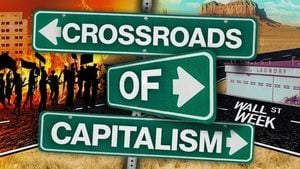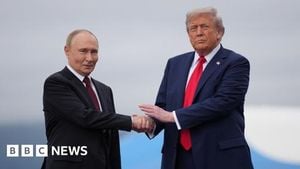In a week marked by extraordinary central bank interventions and mounting economic uncertainty, the Federal Reserve and the People’s Bank of China both injected record amounts of liquidity into their respective financial systems, signaling heightened concerns about global market stability as 2025 draws to a close. These moves, coupled with shifting expectations for interest rate cuts, have sent ripples through risk assets like Bitcoin and gold, while reigniting debate over the health of the U.S. economy and the direction of monetary policy.
On October 31, 2025, the Federal Reserve executed a massive $29.4 billion overnight repo operation, its largest single-day liquidity injection since the dot-com era, according to reporting by multiple financial outlets. The following day, the Fed ramped up its intervention even further, deploying $50.35 billion through its Standing Repo Facility—a historical high for the tool—while the reverse repo facility simultaneously absorbed $51.8 billion. These coordinated actions, timed to address significant month-end collateral needs, reflect the central bank’s ongoing efforts to manage short-term liquidity shortages faced by financial institutions.
Despite the Fed’s official insistence that market conditions remain robust and that the system is flush with "ample reserves," some analysts are raising red flags. As one analyst told Reuters, “these maneuvers are not just minor adjustments but could signal an emerging liquidity crisis that the central bank is working to contain before it becomes more widespread.” The comparison to the 2019 repo crisis, when the Fed stepped in aggressively to plug gaps in the financial system, is not lost on market participants. The analyst added, “The Fed stepping in so aggressively, even while facing record deficits and elevated interest rates, signals a tightening of conditions beneath the surface.”
Historical data supports these concerns. Spikes in repo activity have often preceded broader market repercussions, with the 2008 financial crisis and the 2020 pandemic-induced recession serving as stark reminders of how aggressive Fed policy can both soothe and unsettle markets. Indeed, analysis shows an inverse correlation between rapid Fed funds rate hikes and S&P 500 index performance, with the latter struggling to keep pace with Bitcoin in recent years. As the Fed navigates a fragile economic environment—marked by record government deficits and persistently high interest rates—the risk of further market volatility looms large.
Meanwhile, China’s central bank has been equally proactive. The People’s Bank of China (PBOC) executed a record cash infusion into domestic banks, aiming to support economic growth amid softening demand and a weakened property sector. As reported by Bloomberg, the PBOC’s move is reminiscent of previous crisis responses, with the goal of lowering borrowing costs, stimulating credit growth, and preventing a broader credit crunch. By expanding the global money supply, China’s stimulus could also contribute to asset inflation in both stocks and cryptocurrencies.
The simultaneous liquidity boosts by the Fed and PBOC are being described by macro analysts as a “liquidity tug-of-war” between Washington and Beijing. The Fed is walking a tightrope between curbing inflation and maintaining financial stability, while the PBOC is focused on promoting growth without fueling unsustainable debt. The outcome of this delicate balancing act will have major implications for risk appetite and asset performance heading into 2026.
Bitcoin, often seen as a barometer for risk sentiment, has responded with notable caution. According to Coinglass data cited by CoinDesk, open interest in Bitcoin futures dropped from above 100,000 contracts in October to near 90,000 in early November, signaling wariness among derivatives traders. While Bitcoin’s price has remained relatively steady, many traders are closely watching central bank actions for clues about the next big move. Historically, periods of aggressive monetary easing—such as the post-COVID-19 bull run—have fueled major rallies in Bitcoin and other cryptocurrencies. Yet, as analysts caution, “if the Fed reduces liquidity too soon through scaled-back repo operations or unexpected rate hikes, any positive momentum could quickly vanish.”
Gold, another traditional safe haven, has also felt the effects of shifting monetary policy. On November 3, 2025, gold prices slipped 0.8% to $3,968.76 an ounce after a stronger U.S. dollar and reduced expectations for further Fed rate cuts, according to reporting by The Hustle. The dollar’s surge to a three-month peak made gold and other precious metals more expensive for overseas buyers, prompting outflows from major gold ETFs like the SPDR Gold Trust. Despite a stellar 51% gain earlier in the year, gold is now down more than 10% from its record high of $4,381.21 an ounce reached in October. Easing U.S.-China trade tensions have also reduced safe-haven demand, further weighing on prices.
Behind these market moves lies a deeper debate about the state of the U.S. economy. On November 2, Treasury Secretary Scott Bessent told CNN’s “State of the Union” that parts of the economy—particularly the housing sector—may already be in recession due to high interest rates. “I think that we are in good shape, but I think that there are sectors of the economy that are in recession,” Bessent said, noting that high mortgage rates have hit low-end consumers hardest. Pending home sales in the U.S. were flat in September, according to the National Association of Realtors, underscoring the challenges facing the real estate market.
Bessent was joined by Fed Governor Stephen Miran in calling for the central bank to accelerate rate cuts. Miran, who dissented from the Fed’s recent decision to lower rates by just 25 basis points, warned in a New York Times interview, “If you keep policy this tight for a long period of time, then you run the risk that monetary policy itself is inducing a recession.” Bessent echoed this sentiment, arguing that the Trump administration’s spending cuts—which have lowered the deficit-to-GDP ratio to 5.9% from 6.4%—should help reduce inflation and justify further Fed rate cuts. “If we are contracting spending, then I would think inflation would be dropping. If inflation is dropping, then the Fed should be cutting rates,” he said.
Fed Chair Jerome Powell, for his part, has signaled caution, suggesting that further rate cuts at the December meeting are far from certain—a stance that has frustrated some policymakers and market participants. Polymarket data now puts the odds for a third 2025 rate cut at 65%, down from 90% earlier in the fall, reflecting the market’s growing uncertainty.
As the global financial system enters a period of transition, with central banks weighing the risks of inflation against the dangers of recession, investors are left to navigate a landscape marked by volatility and shifting expectations. The next several weeks will be critical in determining whether the recent liquidity injections can stabilize markets or if deeper cracks in the system will emerge. For now, the only certainty is that central bank policy—and its impact on everything from Bitcoin to gold to real estate—will remain at the center of the world’s economic story.





